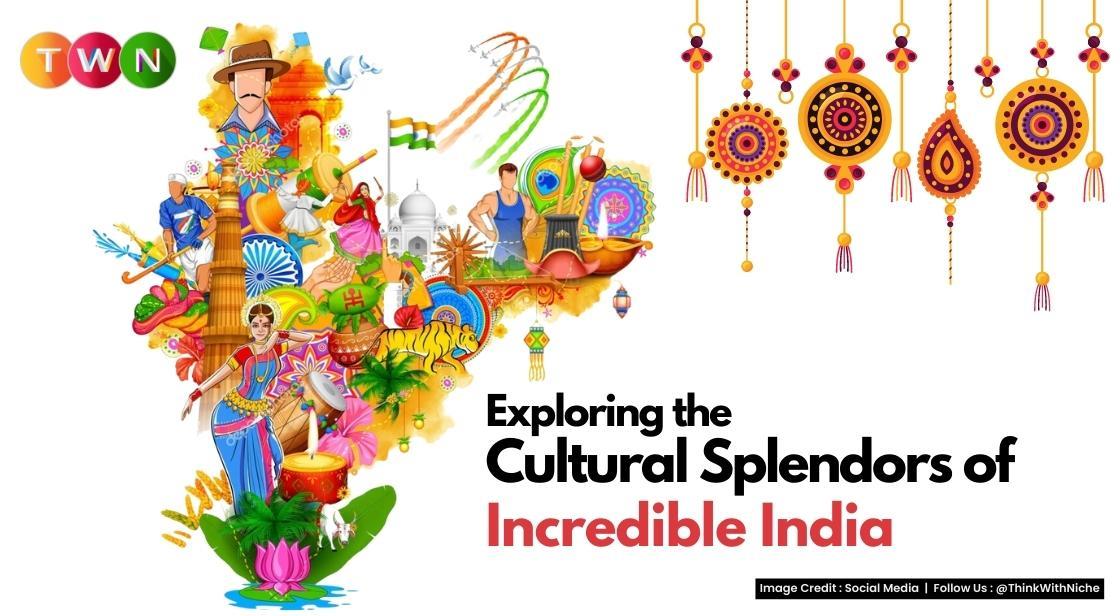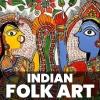Exploring the Cultural Splendors of Incredible India

Blog Post
India, a land of immense diversity and rich heritage, is home to one of the world's most fascinating and captivating cultures. From its ancient traditions and spiritual practices to its vibrant festivals and artistic expressions, Indian culture offers a mesmerizing journey for those seeking to explore its wonders. With a history spanning thousands of years, India has nurtured a tapestry of customs, languages, cuisines, and arts that continue to thrive today.
As we embark on a journey to exploring the Cultural Splendors of Incredible India, we are transported to a realm where ancient traditions blend seamlessly with modern influences, creating a captivating and vibrant mosaic of customs, arts, festivals, and spirituality. This extraordinary tapestry is woven with threads of diversity, heritage, and a deep-rooted sense of community that is unique to India.
From the bustling streets of Delhi to the tranquil backwaters of Kerala, India showcases a vibrant tapestry of cultures, each with its distinct flavors, traditions, and languages. It is a land where a multitude of religions and belief systems coexist harmoniously, resulting in a rich tapestry of spiritual practices, rituals, and festivals that bring communities together in celebration.
India, a land of immense diversity and rich heritage, is home to one of the world's most fascinating and captivating cultures. From its ancient traditions and spiritual practices to its vibrant festivals and artistic expressions, Indian culture offers a mesmerizing journey for those seeking to explore its wonders. With a history spanning thousands of years, India has nurtured a tapestry of customs, languages, cuisines, and arts that continue to thrive today.
Beyond its vibrant traditions and artistic expressions, India holds a deep spiritual wisdom that has been passed down through generations. The practice of yoga, originating in ancient India, has gained global recognition for its profound impact on physical and mental well-being. Meditation, another integral part of Indian spirituality, provides a path to find inner peace and connect with one's higher self.
Join us as we embark on this journey through the amazing culture of India. Uncover the traditions, arts, festivals, languages, cuisines, and spirituality that make India a truly remarkable and fascinating country. Experience the richness of its heritage, the warmth of its people, and the beauty of its customs. India awaits with open arms, ready to captivate and inspire all who are drawn to its enchanting culture.
Exploring the Cultural Splendors of Incredible India
History of Indian Rich culture
The history of India's rich culture is a tapestry woven with threads of ancient civilizations, diverse traditions, and profound cultural influences. Dating back thousands of years, India's cultural heritage has evolved and flourished through various dynasties, empires, and eras, leaving an indelible mark on the country's identity.
India's cultural history can be traced to the ancient Indus Valley Civilization, one of the world's oldest urban civilizations, which thrived around 2500 BCE. The remnants of this civilization, including the planned cities of Harappa and Mohenjo-daro, provide valuable insights into the early social, economic, and artistic practices of the region.
Over the centuries, India witnessed the rise and fall of numerous dynasties and empires, each leaving a unique imprint on its cultural landscape. The Maurya Empire, under the reign of Emperor Ashoka, played a significant role in spreading Buddhism and fostering art and architecture. The Gupta Empire, often referred to as the "Golden Age of India," witnessed advancements in science, mathematics, and the arts.
Indian culture has been shaped by the intermingling of diverse influences, including the arrival of traders, explorers, and invaders from different parts of the world. The Mughal Empire, with its Persian and Central Asian roots, introduced a fusion of Indian and Islamic traditions, leaving an enduring impact on architecture, music, and cuisine. The colonial rule of the British Empire also left its mark on India's cultural landscape, influencing language, education, and governance.
One of the remarkable aspects of Indian culture is its regional diversity. Each state and region boasts its unique customs, traditions, languages, music, dance forms, festivals, and cuisine. From the colorful festivities of Holi in North India to the grand processions of Onam in Kerala and the breathtaking dances of Manipur, India's cultural tapestry is a vivid mosaic of celebrations and traditions.
Religion has played a vital role in shaping India's cultural heritage. Hinduism, Buddhism, Jainism, Islam, Sikhism, and Christianity have coexisted for centuries, enriching the cultural fabric of the country. Temples, mosques, churches, and gurudwaras stand as architectural marvels, reflecting the devotion and spiritual beliefs of millions of Indians.
Indian art forms, including painting, sculpture, music, dance, and literature, have flourished throughout history. The intricate paintings of Ajanta and Ellora caves, the majestic sculptures of Khajuraho, and the classical music traditions of Hindustani and Carnatic are testaments to the artistic prowess and aesthetic sensibilities of the Indian people.
Today, India's rich cultural heritage continues to thrive and evolve, blending ancient traditions with modern influences. It serves as a source of inspiration for artists, scholars, and enthusiasts worldwide, captivating audiences with its depth, diversity, and timeless appeal.
The history of India's rich culture is a testament to the resilience, creativity, and enduring spirit of its people. It serves as a reminder of the country's vibrant past and provides a foundation for the preservation and celebration of its cultural legacy in the present and future.
The Melting Pot of Traditions and Customs:
India's cultural landscape is a fascinating amalgamation of diverse regional customs and traditions. Each state and even smaller regions within them boast their unique rituals, ceremonies, and social practices. Whether it's the grandeur of North Indian weddings, the simplicity of South Indian customs, or the tribal rituals of Northeast India, the country offers an endless array of customs to explore and appreciate.
-
North India
In North India, weddings are celebrated with unparalleled pomp and splendor. The elaborate rituals, vibrant attire, and extravagant decorations create an atmosphere of festivity and joy. From the colorful mehndi (henna) ceremony to the boisterous baraat (groom's procession) and the sacred pheras (wedding vows) around the holy fire, each ritual holds deep cultural significance. The wedding feast, known as the "shaadi ka khana," showcases a delectable array of dishes that tantalize the taste buds and leave guests satiated.
-
South Indian
In contrast, South Indian customs are characterized by their simplicity and adherence to age-old traditions. Weddings in South India often feature the resplendent silk sarees worn by the bride and the groom. The exchange of garlands, known as the "mala maalai" ceremony, signifies their acceptance of each other. The highlight of the ceremony is the tying of the "thaali" or mangalsutra, a sacred necklace symbolizing marital union. The traditional vegetarian feast served on banana leaves, known as the "sadya," offers a delightful culinary experience with its array of flavors and textures.
-
Eastern India
Moving towards the eastern part of the country, we encounter the vibrant festivals and customs of West Bengal. Durga Puja, the grand celebration dedicated to the goddess Durga, is a cultural extravaganza that captivates locals and tourists alike. Elaborate pandals (temporary structures) are erected, showcasing artistic representations of mythological scenes. The air resonates with the beats of traditional drums and the chanting of devotional hymns. The final day, known as Vijayadashami, witnesses the immersion of beautifully crafted clay idols into rivers or water bodies, symbolizing the departure of the goddess.
-
Northeast India
Northeast India, with its diverse tribal communities, offers a glimpse into the rich cultural tapestry of the region. Each tribe has its distinct customs, rituals, and festivals that reflect their unique way of life. The Hornbill Festival in Nagaland brings together various tribes to celebrate their heritage through traditional dances, music, crafts, and sporting events. The Bihu festival in Assam showcases the vibrant folk dances and music of the region, accompanied by feasts of traditional delicacies. These festivals provide an opportunity to witness the indigenous customs and traditions that have been passed down through generations.
Religion plays a significant role in shaping India's customs and traditions. Hinduism, Islam, Christianity, Sikhism, Buddhism, and Jainism are among the major religions practiced in the country. Each religion brings its distinct set of rituals and observances that contribute to the cultural fabric of India. The aarti (ritual offering of light) at Hindu temples, the call to prayer from mosques, the melodious hymns in churches, and the meditative chants in Buddhist monasteries create an atmosphere of spirituality and reverence.
Indian arts and craft
Indian arts and crafts also hold a special place in the country's cultural heritage. From intricate hand-woven textiles like Banarasi silk and Chanderi cotton to exquisite metalwork, pottery, and woodcarving, Indian craftsmanship showcases a deep appreciation for aesthetics and attention to detail. The colorful and intricate embroidery of Rajasthan, the delicate Pashmina shawls of Kashmir, and the graceful pottery of Gujarat are just a few examples of the artistic traditions that have thrived for centuries.
Indian arts and crafts are a testament to the country's rich artistic heritage and reflect the creativity, skill, and cultural depth of its people. The diverse range of art forms found across the country is a testament to India's artistic legacy and its ability to preserve and innovate within traditional practices.
1. Hand-Woven Textiles: Threads of Tradition
Banarasi Silk: The Epitome of Elegance
Banarasi silk is a luxurious fabric known for its opulent designs and intricate weaving techniques. Originating from the city of Varanasi in Uttar Pradesh, these hand-woven sarees and fabrics feature elaborate motifs inspired by nature, such as flowers, birds, and leaves. The use of gold and silver threads adds a touch of regality, making Banarasi silk a cherished choice for weddings and special occasions.
Chanderi Cotton: Delicate Weaves with a Regal Touch
Chanderi cotton, produced in the town of Chanderi in Madhya Pradesh, is renowned for its lightweight texture and sheer elegance. The fabric is known for its unique weaving technique, which combines silk and cotton yarns to create a translucent effect. Chanderi sarees and fabrics often feature delicate patterns and motifs, making them popular for their understated beauty.
2. Metalwork: Transforming Metals into Masterpieces
Jaipur's Kundan and Meenakari Jewelry: A Celebration of Colors
Jaipur, the capital of Rajasthan, is famous for its exquisite Kundan and Meenakari jewelry. Kundan jewelry involves setting precious gemstones in gold, creating stunning pieces adorned with colorful stones. Meenakari, on the other hand, is the art of enameling on metal surfaces, resulting in vibrant and intricate designs. These jewelry forms showcase the expertise of artisans who skillfully combine metals and gemstones to create breathtaking pieces.
Odisha's Filigree Work: Delicate Intricacy in Gold and Silver
Odisha, also known as Odisha, is renowned for its exceptional filigree work. Filigree is the art of shaping thin wires of gold or silver into intricate designs and patterns. The craftsmen meticulously twist and solder these wires to create delicate jewelry pieces, decorative items, and even sculptures.
The filigree work of Odisha is characterized by its fine detailing and ornate motifs inspired by nature, mythology, and religious symbols. The artisans skillfully craft earrings, necklaces, bangles, and pendants adorned with delicate filigree patterns. The precision and intricacy of this art form make each piece a masterpiece, showcasing the rich cultural heritage of Odisha.
Also Read: Discovering India's New Parliament House: Notable Facts and Impressive Features
3. Pottery: Molding Clay, Preserving Heritage
Gujarat's Matki Pottery: Earthy Charm and Traditional Craftsmanship
Gujarat's Matki pottery is a traditional craft that has been passed down through generations. Matki, meaning earthen pot, represents the essence of rural Gujarat. Artisans mold clay by hand, using the coil pottery technique to create beautiful pots with distinct shapes and patterns. The earthen pots are then sun-dried and fired in kilns, resulting in sturdy vessels used for storing water and other household purposes. The simplicity and earthy charm of Matki pottery reflect the connection between art, utility, and everyday life.
Khurja's Blue Pottery: Aesthetic Delight in Shades of Blue and White
Khurja, located in Uttar Pradesh, is famous for its vibrant blue pottery. This art form draws inspiration from the Persian technique and is characterized by its blue and white glaze. Artisans skillfully shape and mold the clay into various forms, including bowls, plates, vases, and tiles. The intricate floral patterns and geometric designs are painted by hand using natural dyes and pigments. The final product is then glazed and fired, resulting in stunning blue pottery pieces that showcase the fusion of Persian and Indian aesthetics.
4. Woodcarving: Stories Carved in Wood
Karnataka's Sandalwood Carving: Fragrance and Intricacy Combined
Karnataka is renowned for its exquisite sandalwood carving, a craft that combines fragrance and intricate design. Sandalwood, known for its sweet aroma, is carefully carved by skilled artisans to create figurines, jewelry boxes, and religious artifacts. The fine detailing and precision in carving bring out the beauty of the wood and the intricate patterns and motifs. Sandalwood carving not only showcases the artistic skill but also carries a spiritual significance, as sandalwood holds a sacred place in Indian rituals and traditions.
Kashmir's Walnut Woodwork: Exquisite Craftsmanship and Cultural Significance
Walnut wood carving is a traditional craft of Kashmir, where artisans transform walnut wood into exquisite furniture and decorative items. The artisans meticulously carve intricate patterns and motifs inspired by nature, Mughal architecture, and Kashmiri folklore. The craftsmanship and attention to detail are visible in the elaborate screens, intricately carved panels, and ornate furniture that adorn homes and heritage structures in the region. Walnut woodwork not only reflects the artistic talent of Kashmiri artisans but also carries the cultural significance of the region's rich history and traditions.
5. Embroidery: Stitching Traditions and Tales
Rajasthani Embroidery: Vibrant Colors and Rich Motifs
Rajasthan is known for its vibrant and intricate embroidery work, which reflects the rich cultural heritage of the region. Each sub-region in Rajasthan has its unique style, such as the colorful and mirror-worked embroidery of Jaisalmer, the intricate and detailed patterns of Jaipur, and theembroidered tapestries and wall hangings of Udaipur.
Rajasthani embroidery is characterized by its vibrant colors, intricate stitches, and rich motifs inspired by nature, folk tales, and royal traditions. The artisans skillfully incorporate various stitching techniques like mirror work, chain stitch, and gota patti (appliqué) to create visually stunning designs on fabrics such as silk, cotton, and georgette. The embroidery is often seen adorning traditional garments like lehengas, sarees, and turbans, as well as home furnishings like cushion covers, tablecloths, and bedspreads.
The Art of Pashmina Shawls: Kashmir's Delicate and Luxurious Textiles
Kashmir's Pashmina shawls are renowned worldwide for their exquisite craftsmanship and luxurious feel. Pashmina, which refers to the fine wool sourced from the underbelly of the Himalayan mountain goat, is carefully hand-woven into delicate shawls by skilled artisans. These shawls are known for their warmth, softness, and intricate embroidery.
The embroidery on Pashmina shawls typically features motifs inspired by nature, such as flowers, paisleys, and birds. The artisans employ traditional stitches like chain stitch, aari work, and needlework to create intricate patterns that adorn the borders, edges, and central panels of the shawls. The art of Pashmina embroidery requires great precision and attention to detail, resulting in shawls that are not only a symbol of luxury but also a testament to the rich cultural heritage of Kashmir.
6. Preserving Heritage: Government Initiatives and Artisan Empowerment
Promoting Indian Arts and Crafts: Exhibitions and Workshops
Recognizing the importance of preserving and promoting India's rich artistic traditions, the government and various organizations regularly organize exhibitions and workshops to showcase the talent of Indian artisans. These events provide a platform for artisans to display their creations and connect with art enthusiasts, collectors, and designers. They also serve as opportunities for cultural exchange, where artisans can learn from each other and explore new techniques and designs.
Market Support and Artisan Welfare: Empowering the Artistic Community
To ensure the sustainability of Indian arts and crafts, efforts are made to provide market support and improve the socio-economic conditions of the artisans. Artisan cooperatives and organizations work towards fair trade practices, ensuring that artisans receive fair wages for their work. Moreover, initiatives are taken to empower artisans through training programs, access to design resources, and financial support. By supporting the artistic community, these initiatives aim to preserve traditional knowledge, encourage innovation, and secure a better future for Indian arts and crafts.
7. Beyond Aesthetics: Cultural Significance and Social Impact
Storytelling through Art: Depicting History, Mythology, and Social Fabric
Indian arts and crafts are not merely decorative but also serve as powerful mediums for storytelling. Each art form carries its own narrative, reflecting historical events, mythological tales, and the social fabric of the communities from which they originate. Through motifs, symbols, and designs, Indian artisans communicate their cultural heritage, beliefs, and values. This cultural storytelling fosters a sense of identity, strengthens community bonds, and helps preserve India's diverse heritage.
Traditional Knowledge and Skill Preservation: Passing the Torch to Future Generations
Indian arts and crafts are often passed down from generation to generation, with knowledge and skills transferred through apprenticeships and familial traditions. This transmission of traditional knowledge ensures the continuity of artistic practices and allows younger generations to inherit and carry forward their cultural legacy. Efforts are made to recognize and support master artisans who play a crucial role in preserving and teaching their craft to apprentices, safeguarding the future of Indian arts and crafts.
Cultural Exchange and Global Appreciation: Attracting Art Enthusiasts Worldwide
Indian arts and crafts have gained international recognition and appreciation, attracting art enthusiasts and collectors from around the world. The unique blend of vibrant colors, intricate designs, and skilled craftsmanship captivates people's attention and fosters cross-cultural understanding. Exhibitions, art fairs, and cultural festivals provide platforms for artists to showcase their works globally, promoting cultural exchange and creating opportunities for collaborations and artistic dialogues between Indian artisans and artists from different parts of the world.
Through cultural exchange, Indian arts and crafts also find their way into international fashion, home decor, and design industries. Traditional Indian textiles, jewelry, and handicrafts have inspired fashion designers, interior decorators, and artists worldwide, leading to collaborations that blend traditional Indian techniques with contemporary designs. This fusion of traditional and modern elements not only breathes new life into Indian arts and crafts but also helps preserve and promote them on a global scale.
In conclusion, Indian arts and crafts represent the diverse and rich cultural heritage of the country. From hand-woven textiles and metalwork to pottery, woodcarving, and embroidery, each art form showcases the meticulous craftsmanship, artistic expression, and cultural significance deeply ingrained in Indian traditions. By preserving these artistic traditions, supporting artisans, and fostering cultural exchange, India celebrates its heritage and ensures that these timeless traditions continue to thrive and inspire generations to come.
Artistic Expressions: From Dance to Music:
Indian culture is renowned for its rich artistic expressions. Classical dance forms like Bharatanatyam, Kathak, Odissi, and Kathakali captivate audiences with their grace, intricate footwork, and expressive storytelling. Traditional music, encompassing genres like Hindustani and Carnatic, resonates with soul-stirring melodies and rhythms. Indian cinema, often referred to as Bollywood, has gained international recognition for its vibrant song and dance sequences.
-
Festivals: A Kaleidoscope of Celebrations:
India's calendar is dotted with numerous festivals celebrated with great enthusiasm and fervor. Diwali, the Festival of Lights, celebrates the victory of light over darkness. Holi, the Festival of Colors, brings people together to rejoice and play with vibrant hues. Eid, Christmas, Navratri, Pongal, and Durga Puja are just a few examples of the diverse religious and cultural festivals celebrated across the country.
-
Languages: The Towering Linguistic Diversity:
India is a linguistically diverse nation, with over 1,600 languages spoken across its vast expanse. Hindi and English serve as the official languages, but each state has its regional language, such as Tamil, Bengali, Telugu, Marathi, and Gujarati. The linguistic diversity reflects the rich cultural heritage and the strong regional identities within India.
-
Gastronomic Delights: A Culinary Adventure:
aromatic biryanis of Hyderabad to the fiery curries of Punjab and the delicate dosas of South India, Indian food offers a tantalizing journey for food enthusiasts. The country's vast geographical and cultural diversity has given rise to a wide array of regional dishes, each with its distinct ingredients and cooking techniques.
-
Spiritual Quest: Yoga and Meditation:
India is the birthplace of yoga and meditation, practices that have gained global recognition for their profound impact on physical and mental well-being. The ancient wisdom of yoga, with its various asanas (postures) and pranayama (breathing techniques), provides a path to achieve harmony and balance. Meditation, another integral part of Indian spirituality, offers a means to find inner peace and connect with one's higher self.
-
Architectural Marvels: From Temples to Palaces:
Indian architecture showcases a splendid blend of ancient craftsmanship and intricate design. From the awe-inspiring temples of Khajuraho and the majestic forts of Rajasthan to the elegant palaces of Mysore and the iconic Taj Mahal, India's architectural marvels are a testament to its rich history and cultural heritage. Each structure tells a story, reflecting the artistic sensibilities and architectural brilliance of its era.
-
Traditional Attire: Colors and Elegance:
The traditional attire of India is a kaleidoscope of colors, fabrics, and intricate craftsmanship. From the vibrant sarees of Maharashtra and the graceful lehengas of Rajasthan to the dhotis and kurtas worn by men, Indian clothing reflects the diverse cultural identities and regional influences. Embroidery, block printing, and handloom weaving techniques add a touch of elegance to the attire, making it a visual delight.
-
Healing Wisdom: Ayurveda and Wellness:
India is renowned for its ancient system of medicine known as Ayurveda, which focuses on achieving holistic well-being. Ayurveda emphasizes the balance of mind, body, and spirit through personalized treatments, herbal remedies, and lifestyle practices. From rejuvenating massages and herbal therapies to specialized diets and yoga, Ayurveda offers a natural and comprehensive approach to wellness.
-
Preserving and Promoting Indian Culture:
In recent years, there has been a growing emphasis on preserving and promoting Indian culture. Various organizations, both governmental and non-governmental, are working tirelessly to safeguard and promote the country's cultural heritage. Efforts are being made to revive traditional art forms, support artisans, and create platforms for cultural exchange and collaboration. Festivals and cultural events are celebrated with great enthusiasm, serving as a platform to showcase India's diverse traditions and talents.
Conclusion:
India's amazing culture is a treasure trove of customs, arts, festivals, languages, cuisines, and spiritual practices. Its richness lies in the harmonious coexistence of ancient traditions and modern influences, creating a vibrant and dynamic cultural tapestry. From the colorful festivals that bring communities together to the exquisite art forms that captivate audiences worldwide, Indian culture is a testament to the country's deep-rooted heritage and creative spirit.
As we delve into the diverse facets of Indian culture, we discover a world of traditions, languages, flavors, and spirituality that leave an indelible mark on our hearts and minds. Whether it's exploring the architectural wonders, savoring the tantalizing flavors, immersing ourselves in the rhythmic beats of music and dance, or seeking inner peace through yoga and meditation, India offers a transformative experience.
You May Like
EDITOR’S CHOICE












